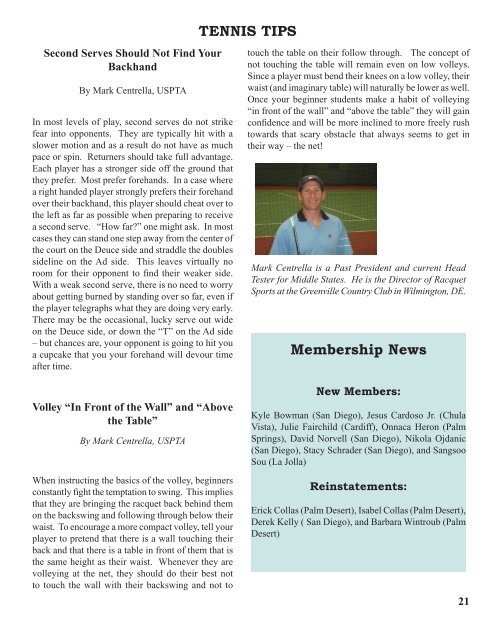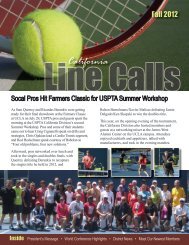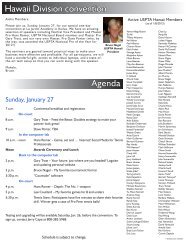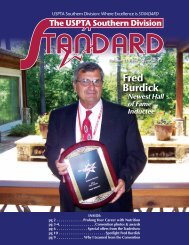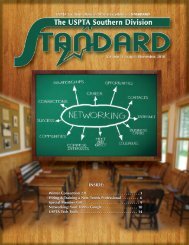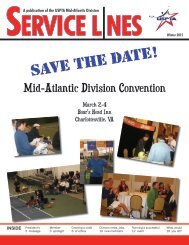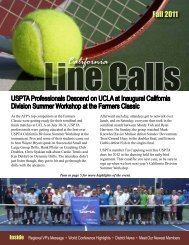SD Newsletter Fall 2011 final.indd - USPTA divisions - United States ...
SD Newsletter Fall 2011 final.indd - USPTA divisions - United States ...
SD Newsletter Fall 2011 final.indd - USPTA divisions - United States ...
You also want an ePaper? Increase the reach of your titles
YUMPU automatically turns print PDFs into web optimized ePapers that Google loves.
Second Serves Should Not Find Your<br />
Backhand<br />
By Mark Centrella, <strong>USPTA</strong><br />
In most levels of play, second serves do not strike<br />
fear into opponents. They are typically hit with a<br />
slower motion and as a result do not have as much<br />
pace or spin. Returners should take full advantage.<br />
Each player has a stronger side off the ground that<br />
they prefer. Most prefer forehands. In a case where<br />
a right handed player strongly prefers their forehand<br />
over their backhand, this player should cheat over to<br />
the left as far as possible when preparing to receive<br />
a second serve. “How far?” one might ask. In most<br />
cases they can stand one step away from the center of<br />
the court on the Deuce side and straddle the doubles<br />
sideline on the Ad side. This leaves virtually no<br />
room for their opponent to fi nd their weaker side.<br />
With a weak second serve, there is no need to worry<br />
about getting burned by standing over so far, even if<br />
the player telegraphs what they are doing very early.<br />
There may be the occasional, lucky serve out wide<br />
on the Deuce side, or down the “T” on the Ad side<br />
– but chances are, your opponent is going to hit you<br />
a cupcake that you your forehand will devour time<br />
after time.<br />
Volley “In Front of the Wall” and “Above<br />
the Table”<br />
By Mark Centrella, <strong>USPTA</strong><br />
When instructing the basics of the volley, beginners<br />
constantly fi ght the temptation to swing. This implies<br />
that they are bringing the racquet back behind them<br />
on the backswing and following through below their<br />
waist. To encourage a more compact volley, tell your<br />
player to pretend that there is a wall touching their<br />
back and that there is a table in front of them that is<br />
the same height as their waist. Whenever they are<br />
volleying at the net, they should do their best not<br />
to touch the wall with their backswing and not to<br />
TENNIS TIPS<br />
touch the table on their follow through. The concept of<br />
not touching the table will remain even on low volleys.<br />
Since a player must bend their knees on a low volley, their<br />
waist (and imaginary table) will naturally be lower as well.<br />
Once your beginner students make a habit of volleying<br />
“in front of the wall” and “above the table” they will gain<br />
confi dence and will be more inclined to more freely rush<br />
towards that scary obstacle that always seems to get in<br />
their way – the net!<br />
Mark Centrella is a Past President and current Head<br />
Tester for Middle <strong>States</strong>. He is the Director of Racquet<br />
Sports at the Greenville Country Club in Wilmington, DE.<br />
Membership News<br />
New Members:<br />
Kyle Bowman (San Diego), Jesus Cardoso Jr. (Chula<br />
Vista), Julie Fairchild (Cardiff), Onnaca Heron (Palm<br />
Springs), David Norvell (San Diego), Nikola Ojdanic<br />
(San Diego), Stacy Schrader (San Diego), and Sangsoo<br />
Sou (La Jolla)<br />
Reinstatements:<br />
Erick Collas (Palm Desert), Isabel Collas (Palm Desert),<br />
Derek Kelly ( San Diego), and Barbara Wintroub (Palm<br />
Desert)<br />
21


